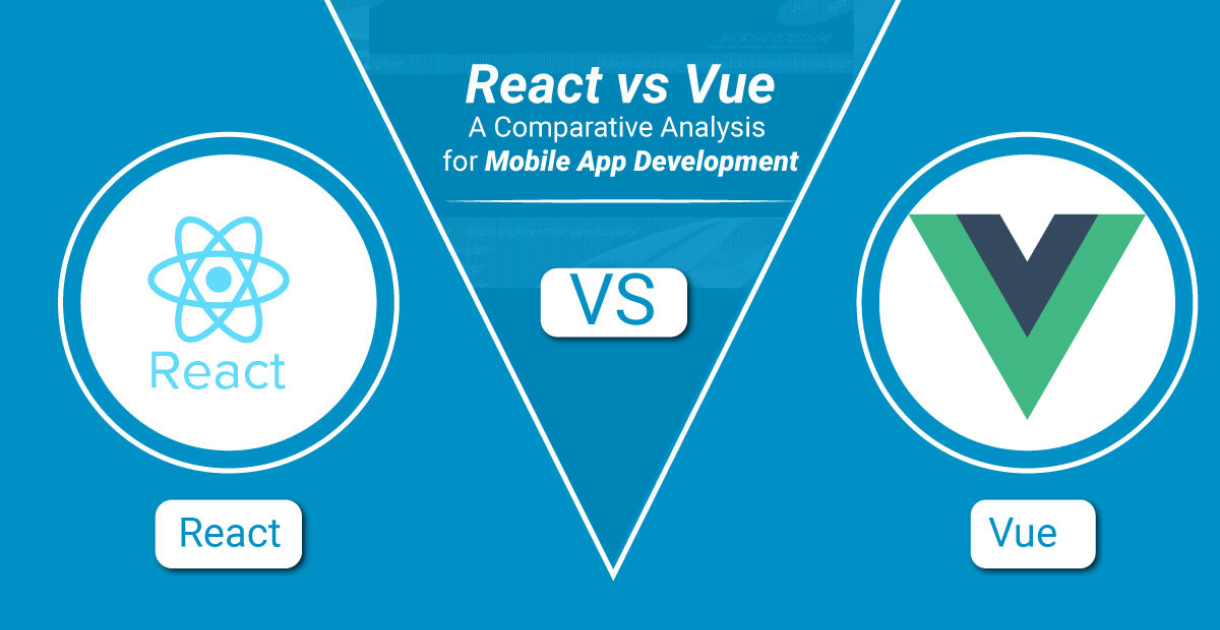Introduction: React vs Vue Overview
In the modern web development landscape, React vs Vue has emerged as two of the most popular front-end JavaScript frameworks for building feature-rich and performant applications. Both frameworks take a component-based approach and offer powerful tools to create dynamic user interfaces.
When it comes to mobile app development, Vue framework and React provide frameworks to build cross-platform native mobile apps using React and Vue. This has further increased the popularity and adoption of these frameworks.
For mobile app developers evaluating options for their next project, choosing between react JS framework vs vue js can be challenging given their similarities. This article analyses the key differences between React and Vue with a focus on mobile app development to help make an informed choice.
React vs Vue: Origins and Popularity
React was developed internally at Facebook in 2011 and later open-sourced in 2013. Since then, it has gained widespread adoption across many industries due to its composability, performance, and large ecosystem.
Vue was created by Evan You in 2014 and focuses on usability while being incrementally adaptable. It has grown rapidly in popularity due to its approachable learning curve and flexibility.
According to the State of JS survey in 2022, React remains the most popular framework with 29.5% usage, followed closely by Vue at 20.8%. Angular falls behind in third place with 10.8%.
When it comes to mobile React Native App Development, React Native dominates the market with a user base of over 500,000 developers. Vue Native is relatively new but growing fast with its cross-platform capabilities.
React vs Vue: Component Model
Both React and Vue follow a component-based approach to building user interfaces. Components help divide the UI into independent and reusable pieces.
In React, components are defined as classes that extend React. Component or function components. They accept props as input and return JSX elements.
Vue components are also defined as classes or plain options objects. They accept props and emit events as output. Vue components can contain templates, scripts, and style sections.
The key difference is that React uses a virtual DOM for rendering while Vue uses its own runtime for reactivity and rendering. This makes Vue generally faster for rendering simple components.
React vs Vue: Templating
React follows a JSX syntax for defining templates which compiles to regular JavaScript. This makes React code look more like HTML but requires transpiration.
Vue uses plain HTML templates with its own directives like v-for, v-if and v-bind. No transpiration is needed. This makes Vue templates simpler and faster to render.
However, JSX brings the power of JavaScript expressions inside templates. Features like inline conditional rendering and iterators are more natural in JSX.
For mobile apps, the performance difference between JSX and Vue templates is negligible in most cases. Both allow for building dynamic UIs effectively.
React vs Vue: Reactivity System
At the core, both frameworks implement reactivity through a declarative paradigm.
In React, the state and props of a component determine the output. State changes trigger re-renders using shallow comparison of objects and arrays.
Vue uses a reactivity system where it tracks dependencies and triggers updates asynchronously. It converts plain JavaScript objects to reactive proxies behind the scenes.
This makes Vue generally more performant for large data changes since it only updates relevant portions of the UI. But React optimizations like shouldComponentUpdate help minimise unnecessary re-renders.
For mobile apps, both frameworks React vs Vue provide efficient ways to build reactive UIs. React uses shouldComponentUpdate lifecycle method while Vue relies on its internal tracking. Performance is comparable in most cases.
React vs Vue: Routing
React Router is the dominant routing library for React applications. It supports route matching, navigation, and dynamic rendering of views.
Vue Router is the official routing solution for Vue. It is lightweight and works seamlessly with Vue components and applications.
Both libraries allow defining route configurations, nested routes, and route parameters. They also support features like lazy loading, auth guards and nested layouts. For mobile apps, React Native Navigation and Vue Native Navigation provide routing capabilities within native apps. Overall, routing is well supported in both frameworks.
React vs Vue: State Management
Managing the state is crucial for any application. React encourages using a separate state management library like Redux while Vue has Vuex for centralised state management built in.
Redux follows a flux-inspired unidirectional data flow architecture. It involves more boilerplate code compared to Vuex.
Vuex allows defining modules, getters, mutations, and actions in a more natural way. It integrates seamlessly with Vue reactivity.
For mobile apps, both Redux and Vuex work well for global state management. Local component state is also sufficient in many cases. Overall, Vuex has a lower learning curve.
React vs Vue: Form Handling
Handling forms is an essential part of any application. In React, form state is typically managed in a component using local state or Redux. Libraries like Formik and React Hook Form simplify form handling.
Vue provides a v-model directive to sync form inputs with component data. It also has validation plugins like Vuelidate for easy form validation. For mobile apps, both frameworks allow building forms by syncing UI with local component state or Vuex/Redux. Vue’s v-model offers a simpler approach compared to controlled inputs in React.
React vs Vue: Developer Experience
React has a more extensive ecosystem of third-party libraries and tools. It is backed by large companies like Facebook and has a very active community.
Vue has a more gentle learning curve and an approachable API. Its documentation is very well organised compared to React.
Both frameworks have strong IDE support with features like auto-completion and refactoring. React and Vue codebases are also easy to test using libraries like Jest and React Testing Library.
For Mobile Development in React vs Vue, React Native has more learning resources available compared to Vue Native. But Vue Native is catching up quickly with its cross-platform capabilities.
React vs Vue: Performance
In terms of raw rendering performance, Vue has an advantage due to its runtime optimizations and template compilation.
However, React has improved significantly with hooks, context and memoization. Its performance is now on par with Vue for most applications.
For mobile apps, both frameworks provide efficient ways to build reactive UIs. React uses shouldComponentUpdate while Vue relies on its internal tracking. Performance is comparable.
Overall, for simple views, Vue may be faster but for complex apps with many components, the difference is negligible in real-world usage. Optimization techniques help maximise performance in both.
React vs Vue: Which is Best for Mobile Apps?
While both React and Vue can build high-quality mobile applications, there are a few factors that make Vue a better choice in many cases:
- Approachable API: Vue’s declarative syntax, reactivity system and built-in features like v-model make it easier to learn compared to React.
- Performance: Vue’s reactivity optimizations and template compilation provide better performance for simple views and forms.
- Ecosystem: Vue Native is growing rapidly and supports features like Expo integration, while React Native has fragmentation issues.
- Form Handling: Vue’s v-model directive simplified building forms compared to controlled components in React.
- State Management: Vuex integrates seamlessly with Vue reactivity compared to Redux’s separate architecture.
However, react still has advantages like a more extensive library ecosystem and large community resources. It is also backed by major companies.
React vs Vue: Conclusion
Overall, for most mobile projects, between React and Vue, Vue provides an approachable and performant solution. But React remains a powerful choice as well, especially for more complex applications. Both frameworks allow the building of high-quality cross-platform mobile apps.
The best approach is to try out sample projects in both and evaluate which one aligns better with your specific requirements and development style. With continuous improvements, both React vs Vue will remain relevant choices for building next-gen mobile experiences.
If you need someone to manage all project needs and provide innovative, trustworthy solutions that can significantly increase your company’s future growth potential, get in contact with Monarch Innovation. Monarch Innovation develops customised solutions to help customers re-engineer their production processes to optimise the effectiveness and output of their organisations.
FAQs
Q.1 Which is better for small-scale projects, React or Vue?
Answer – Both React and Vue are suitable for small-scale projects. Vue’s simplicity may be advantageous, while React’s scalability makes it a strong choice for future growth.
Q.2 How do React and Vue handle component reusability?
Answer – A: Both React and Vue support component-based architecture, allowing developers to create reusable components. However, Vue’s single-file components make it especially convenient.
Q.3 Which framework is more suitable for mobile app development, React or Vue?
Answer: Both React Native (for React) and Vue Native (for Vue) enable mobile app development. React Native has a larger community and more extensive third-party libraries, making it a popular choice.
Q.4 Can React be used for server-side rendering (SSR)?
Answer – Yes, React has strong support for server-side rendering. This can enhance performance and provide search engine optimization (SEO) benefits by serving pre-rendered content to clients.






